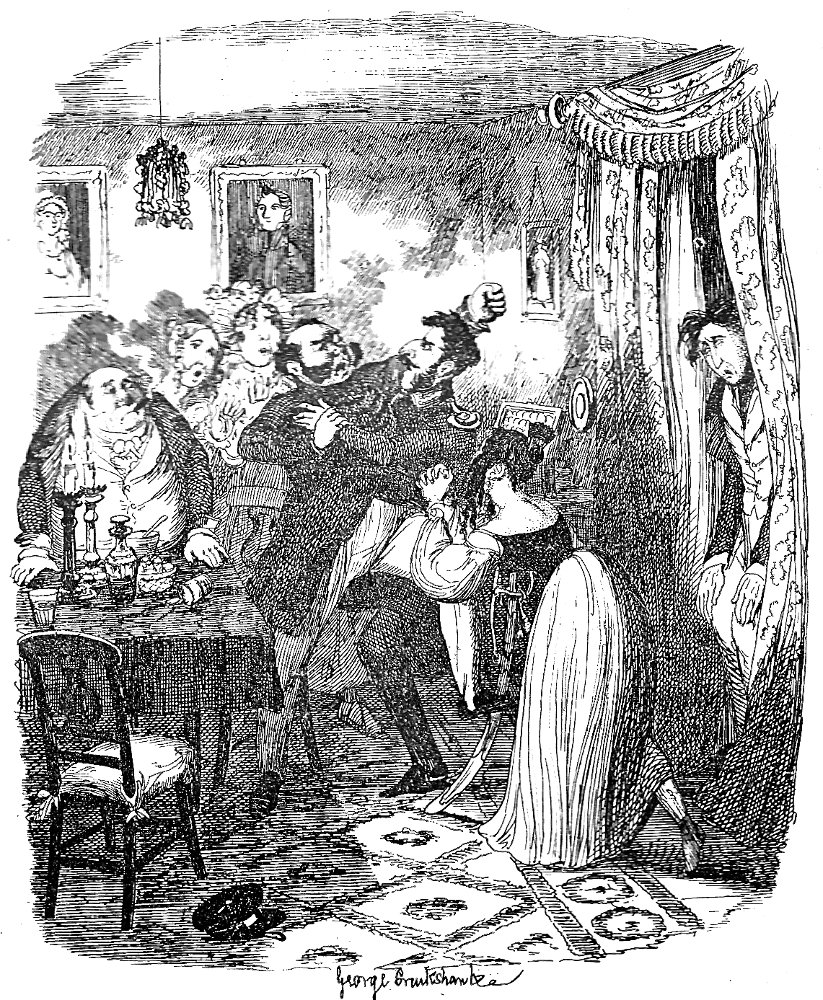
Frontispiece: The Tuggses Ramsgate. Drawn by A. B. Frost. Wood engraving. For "Tales: IV," in Dickens's Sketches by Boz Illustrative of Every-day Life and Every-Day People, facing title-page (87). This full-page illustration opposite the internal title-page of the "Tales" section of the Household Edition volume, which showcases Frost's skills as a draughtsman and engraver, demonstrates his ability to depict motion — in this case, Frost captures and individualizes the movements of all seven figures involved in the donkey-ride, including the excited dog. Click on the image to enlarge it.
Scanned image, colour correction, sizing, caption, and commentary by Philip V. Allingham. [You may use this image without prior permission for any scholarly or educational purpose, as long as you (1) credit the person who scanned the image, and (2) link your document to this URL in a web document or cite the Victorian Web in a print one.]
Passage Illustrated
Mr. Cymon Tuggs blushed, smiled, looked vacant, and faintly protested that he was no horseman. The objection was at once overruled. . . .
"Way — way! Wo — o — o —!" cried Mr. Cymon Tuggs as well as he could, in the midst of the jolting.
"Don't make it gallop!" screamed Mrs. Captain Waters, behind.
"My donkey will go into the public-house!" shrieked Miss Tuggs in the rear. ["Tales," No. IV: "The Tuggses at Ramsgate," p. 221]
Commentary: Cymon in Motion and Steep Aerial Perspective
British artists Robert Seymour and George Cruikshank had illustrated this short story for Chapman and Hall's Library of Fiction (1836-39) in the same farcical manner. Although Frost might have been aware of earlier illustrations in a caricatural mode and undoubtedly had seen the Eytinge wood-engraving in the edition issued to coincide with Dickens's second American tour, he chose to imprint his own whimsical but realistic style on this key moment in the little satire of the Regency nouveau riche.
Frost places his principal subject, Cymon and the obstreperous donkey, in the immediate foreground, and the ladies and their mounts in the distant background. In selecting a difficult scene for his illustration, Frost may have paid homage to earlier artists' handlings of the accidental ride of Abraham Cowley's inept horseman in the 1782 poem The Diverting History of John Gilpin, which both Cruikshank and Phiz illustrated in 1833.
Frost deviates from the text of the sketch in one notable particular: Cymon not the callow youth of Dickens's satire but someone more like the harried, middle-aged bachelor Ichabod Crane of Washington Irving's "Legend of Sleepy Hollow." In the 1820 short story (which Irving actually wrote while in England), the fatuous schoolmaster, returning home from a dance late at night, must ride for his life, pursued by the legendary Headless Hessian. Coupled with the fact that Ichabod is no horseman and his mount, a temperamental, broken-down plough-horse, barely stays ahead of the evil spirit's coal-black stallion as they race for the bridge that marks the limit of the demon's supernatural powers.
Frost has also realised the climactic discovery of Cymon's hiding behind the curtains in Belinda Waters' apartment, "What do I see?" in the American Household Edition, jointly illustrated by Frost and political cartoonist Thomas Nast).
Relevant Material
- Reading and Disucssion Questions for "The Tuggses at Ramsgate" (1836)
- Great Expectations in "The Tuggses at Ramsgate," or, The Importance of Being Cymon
- The Meaning of "Walter" in "The Tuggses at Ramsgate"
Relevant illustrations from other 19th editions, 1836-1876



Left: Cruikshank's copper-engraving of the discovery scene in the little prose farce, "The Tuggses at Ramsgate" (1836). Centre: The second of Robert Seymour's steel-engravings for the story, Vengeance of Captain Walter Waters and Lieutenant Slaughter. Mr. Cymon Tuggs discovered behind the curtains, at the Waters's lodgings (1836). Right: The Ticknor-Fields' Diamond Edition illustration for the story, in which fellow American illustrator Sol Eytinge, Jr., depicts both the married lady and the naive Cymon on their donkeys, "The Tuggses at Ramsgate" (1867).

Above: Fred Barnard's group study of the Waters, Slaughter, and the Tuggses, "So exactly the air of a marquis," said the military gentleman (1876) in the British Household Edition. [Click on images to enlarge them.]
Bibliography
Barnard, J. "Fred" (il.). Charles Dickens's Sketches by Boz, with thirty-four illustrations. The Works of Charles Dickens: The Household Edition. 22 vols. London: Chapman and Hall, 1876. Volume 13.
Barnard, Fred, et al. Scenes and Characters from Dickens. London: Chapman & Hall, 1908.
Dickens, Charles. Sketches by Boz. Illustrated by George Cruikshank. London: Chapman & Hall, 1836.
Dickens, Charles. Sketches by Boz. Illustrated by F. O. C. Darley and John Gilbert. The Works of Charles Dickens. The Household Edition. 55 vols. New York: Sheldon and Company, 1864. Vols. 1-2.
Dickens, Charles. Sketches by Boz. Illustrated by Harry Furniss. The Charles Dickens Library Edition. 18 vols. London: Educational Book, 1910. Vol. 1.
Dickens, Charles. Pictures from Italy, Sketches by Boz and American Notes. Illustrated by Thomas Nast and Arthur B. Frost. New York: Harper & Brothers, 1877 (copyrighted in 1876).
Last modified 26 February 2019